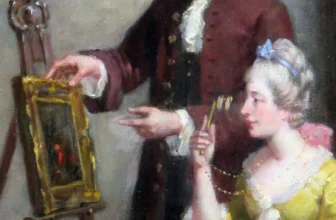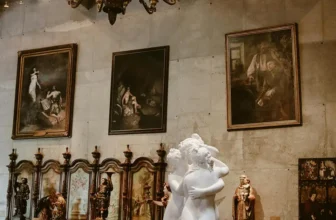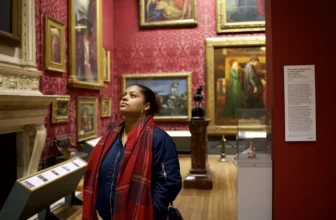The Enigmatic Vision of “Newton” by William Blake
William Blake, the 18th-century poet, visionary, and artist, has long stood apart from his contemporaries. Rather than embracing the Age of Reason and the empirical methodologies that dominated his time, Blake challenged the prevailing ideologies of Enlightenment thought. Among his many profound works, the painting Newton (circa 1795–1805) remains one of the most evocative and symbolically rich pieces in his oeuvre. This remarkable artwork is more than a portrait, it is a philosophical manifesto, a visual critique, and a mystical allegory that delves deep into Blake’s spiritual and metaphysical beliefs. To understand Newton by William Blake is to enter the complex and often contradictory world of an artist who sought to reconcile vision with form, imagination with reason, and the divine with the human.
William Blake and the Age of Reason
Before analyzing Newton specifically, it is essential to understand the broader intellectual environment that shaped Blake’s worldview. Born in 1757 in London, William Blake lived during a time of dramatic political, scientific, and philosophical upheaval. The Enlightenment was in full swing, and with it came a firm belief in rationalism, empiricism, and the power of scientific observation to explain the universe.
Isaac Newton (1642–1727), though he had passed before Blake’s time, had become an icon of Enlightenment thought. Newton’s theories of motion and gravity, his work in optics and calculus, and his overall methodology of rational investigation placed him at the center of this new worldview. Newton’s universe was a mechanistic one, ordered, measurable, and governed by universal laws.
Blake, however, rejected this rationalist orthodoxy. He viewed Newtonian science, and by extension, the Enlightenment itself, as reductive and spiritually barren. For Blake, an overemphasis on reason stifled the imagination and severed humanity from the divine energies of the cosmos.
The Creation of “Newton” by William Blake
William Blake created Newton around 1795–1805, using a unique technique he had developed himself called “monotype printmaking.” This method involved painting directly onto a copper plate using colored inks or paints and then pressing paper onto the plate while the paint was still wet. After transferring the image, Blake would often work back into the print with watercolor or ink to refine details and enhance color. The result was a hybrid of print and painting, giving his works a dreamy, fluid texture that suited his visionary subjects.
Blake produced a series of large color prints during this period, often referred to as his “Large Colour Prints” or “Great Red Dragon” series. Newton was part of this body of work, along with other famous pieces such as Nebuchadnezzar, The Ghost of a Flea, and The Ancient of Days. Each of these pieces reflects Blake’s complex mythological and philosophical system, a synthesis of Christian mysticism, personal mythology, and radical social commentary.
The painting of Newton specifically shows Isaac Newton seated naked on a rock, hunched over a geometric diagram. The figure is illuminated by a mysterious light, possibly emanating from the parchment he draws upon. The background is dark, aquatic, and cavernous, almost primordial, suggesting a world that exists outside conventional space and time.
What Is Happening in the Painting “Newton”?
In Blake’s Newton, we see the great scientist depicted in an introspective, almost trance-like state. Newton is seated at the bottom of the ocean, completely nude, with his body tightly curled inward. He appears absorbed in his work, measuring or drawing on a scroll with a compass. His pose is reminiscent of classical sculpture, but also evokes a sense of detachment from his surroundings.
This underwater setting is particularly intriguing. The rock upon which Newton sits is covered in coral, moss, and other sea life, indicating that this is no ordinary earthly environment. It is a place removed from light and air, perhaps symbolizing a world submerged in the darkness of pure materialism.
Crucially, Newton is entirely oblivious to the organic beauty around him. While coral and algae flourish under his seat, he focuses solely on the abstract geometries on his scroll. He is absorbed in measurement, in rational thought, blind to the vibrant life of the natural world. This contrast between Newton’s narrowed focus and the richness of his surroundings is central to Blake’s message.
Symbolism and Meaning of “Newton”
The symbolism in Newton is rich and multilayered. At its core, the painting critiques the Enlightenment’s glorification of reason and empirical science at the expense of imagination and spiritual insight.
1. Nudity and Vulnerability
Newton’s nudity may suggest vulnerability, but in Blake’s hands, it is more likely a nod to the classical tradition. However, unlike the heroic nudity seen in Renaissance and neoclassical art, Newton’s nudity here suggests exposure, isolation, and perhaps even sterility. There is no eroticism or dynamism, only detachment and stillness.
2. The Compass
The compass is a potent symbol in Blake’s mythology. Traditionally associated with architecture and geometry, the compass here represents the tools of scientific measurement, the instruments of rational inquiry. Blake had used a similar symbol in The Ancient of Days, where the figure of Urizen (his personification of reason and law) also wields a compass to measure the void. In both cases, the compass becomes a symbol of intellectual confinement, a tool that limits the infinite through rationalization.
3. The Scroll
The scroll Newton measures is blank except for the lines he inscribes, reinforcing the idea that he creates his own confined reality through geometry. It symbolizes how Enlightenment thinking tries to map and control the world through systems and data, erasing mystery and subjectivity in the process.
4. The Setting
The ocean floor setting evokes a sense of primal creation, a realm of hidden life and mysterious depths. Blake often associated water with imagination and spiritual insight. Thus, Newton’s ignorance of his surroundings suggests a blindness to the spiritual world, a detachment from divine creativity. He sits in the midst of mystery but sees only numbers.
Interpretation: Blake’s Critique of Newtonian Thought
To Blake, Newton represented the tyranny of reason, a force that constrains the human spirit rather than liberating it. In his writings, Blake often attacked figures like Newton, Francis Bacon, and John Locke, whom he saw as apostles of rationalism and empiricism. He grouped them as part of what he called “Single Vision”, a myopic worldview that reduces all experience to what can be observed and measured.
Blake believed that such a worldview led to spiritual impoverishment and artistic sterility. Instead of embracing the full spectrum of human experience, including emotion, intuition, and vision, Enlightenment thinkers, in his view, confined reality within the narrow framework of logic.
In Newton, this critique is visually embodied. The scientist sits alone, divorced from both nature and spirit, enacting the tragedy of a mind that sees only what it can quantify.
What Kind of Art is “Newton”?
Newton is difficult to classify within traditional art historical categories. It is both a monotype print and a painting, blending techniques in a way that anticipates modern and contemporary multimedia art. Stylistically, the work belongs to Romanticism, particularly its visionary and mystical strain, but it also shares affinities with Symbolism, Surrealism, and even proto-Expressionism.
In thematic terms, Blake’s work could be considered a form of philosophical art, not just aesthetic expression, but a profound commentary on the nature of reality, perception, and the soul. His combination of image and text, and his use of mythic and spiritual allegory, place him outside conventional art movements and more in the realm of a visionary prophet-artist.
The Legacy and Influence of “Newton”
Though Blake was largely ignored during his lifetime, his influence grew significantly in the 19th and 20th centuries. His critique of scientific materialism found echoes in Romantic poets like Coleridge and later in the Symbolist and Surrealist movements. The image of Newton has been reproduced widely, analyzed in both artistic and philosophical circles, and interpreted anew in light of modern debates about science, religion, and art.
Blake’s distrust of reductive rationalism resonates in contemporary conversations around artificial intelligence, data-driven societies, and the loss of human connection in a technological age. Newton thus remains a vital, even prophetic, image for our times.
Current Location of the “Newton” Painting
The original print of Newton by William Blake is housed at the Tate Britain in London, United Kingdom. It is part of the museum’s permanent collection, which includes several other works by Blake. The Tate has played a significant role in preserving and promoting Blake’s legacy, curating exhibitions and publishing scholarship on his art and poetry.
Over the years, Newton has been displayed in various retrospectives and exhibitions around the world, often featured as a centerpiece in discussions about Blake’s relationship to science, mysticism, and Romanticism. Its enduring visual and philosophical power ensures that it continues to captivate scholars, artists, and general viewers alike.
William Blake’s Newton is not merely a portrait, it is a profound critique of a worldview. In this powerful image, Blake warns us of the dangers of intellectual reductionism, of a world that prizes measurement over meaning, and logic over love. At the same time, he offers a vision of alternative ways of knowing, through intuition, imagination, and spiritual insight.
Newton challenges us to consider what we might be missing in our own obsessive focus on progress, data, and analysis. Are we, like Newton in the painting, bent over our own scrolls, blind to the world of beauty and mystery around us?
In this sense, Newton is not just a work of art, it is a mirror, a question, and a call to awaken the divine imagination within us all.




